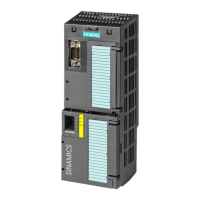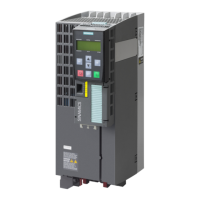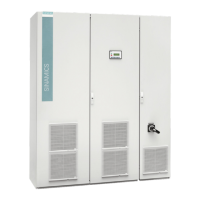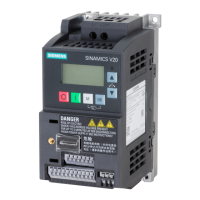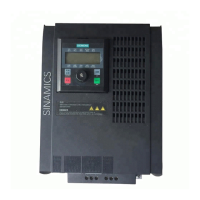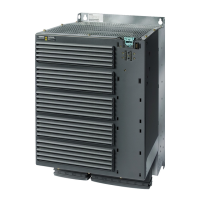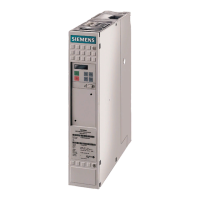What to do if Siemens DC Drives display alarm A03520?
- Jjeffrey37Sep 5, 2025
If alarm A03520 appears, check that the sensor is connected correctly.




What to do if Siemens DC Drives display alarm A03520?
If alarm A03520 appears, check that the sensor is connected correctly.
What to do if Siemens SINAMICS G120C shows F07801 motor overcurrent error?
To address the F07801 motor overcurrent issue in your Siemens Inverter, check the current limits (p0640). If using V/f control, inspect the current limiting controller (p1340 … p1346).
How to resolve F30002 DC-link voltage overvoltage on Siemens SINAMICS G120C Inverter?
To resolve the F30002 DC-link voltage overvoltage error on your Siemens Inverter, increase the ramp-down time (p1121), set the rounding times (p1130, p1136), and activate the DC-link voltage controller.
How to troubleshoot F07860 External fault 1 on Siemens SINAMICS G120C?
To resolve the F07860 External fault 1 error on your Siemens Inverter, remove the external causes for this fault.
How to resolve F07426 Technology controller actual value limited on Siemens SINAMICS G120C Inverter?
To resolve the F07426 Technology controller actual value limited error on your Siemens Inverter, adapt the limits to the signal level.
What to do if Siemens Inverter shows F01001 FloatingPoint exception?
To resolve the F01001 FloatingPoint exception on your Siemens Inverter, switch off the inverter and switch it on again.
What to do if Siemens DC Drives display faults F07086 F07088?
If faults F07086 or F07088 are displayed, check the adapted parameter values and correct them if required.
How to fix A50010 PROFINET name of station invalid on Siemens SINAMICS G120C Inverter?
To resolve the A50010 PROFINET name of station invalid error on your Siemens Inverter, correct the name of station (p8920) and activate (p8925 = 2).
What to do if Siemens SINAMICS G120C displays A01590 Motor maintenance interval elapsed?
To address the A01590 Motor maintenance interval elapsed on your Siemens Inverter, carry out the maintenance.
How to fix F07016 Motor temperature sensor fault on Siemens Inverter?
To resolve the F07016 Motor temperature sensor fault on your Siemens Inverter, make sure that the sensor is connected correctly and check the parameterization (p0601).
Covers electrical shock, fire, and general safety precautions for operation.
Details how to prevent damage to electronic components from ESD.
Explains that application examples are not binding and user is responsible for correct operation.
Provides guidance on protecting systems against cyber threats and malware.
Lists residual risks from control and drive components of power drive systems.
Describes the purpose, target audience, and content of the operating instructions.
Provides a chapter-by-chapter overview of the manual's content and questions answered.
Defines the purpose of the converter and its intended applications.
Mentions the use of software from the OpenSSL project and cryptographic software.
Outlines the procedure for transferring license terms to a PC.
Lists the components included in the delivery for FSAA ... FSC frame sizes.
Lists the components included in the delivery for FSD ... FSF frame sizes.
Lists relevant European directives and standards for converter compliance.
Describes optional components like line filters, line reactors, and sine-wave filters.
Details supported Siemens and third-party motors, and multi-motor operation.
Instructions on attaching the North American market danger and warning label.
Guidance on EMC-compliant installation by subdividing cabinets into zones.
Details on assigning devices to zones and electromagnetically uncoupling them.
Explains cable routing and EMC-compliant wiring for high and low interference cables.
Information on surge voltage protection circuits for various components.
Provides dimensions and mounting equipment details for base components.
Covers mounting position, protection against fire spread, condensation, and dimensions.
Recommends mounting shield plates for EMC compliance and cable strain relief.
Details mounting shield plates and EMC connecting brackets for FSD ... FSE.
Provides drilling patterns and mounting equipment for control cabinet panels.
Instructions for mounting converters on a TS 35 standard mounting rail.
Covers mounting position and clearances for line reactors.
Provides dimensions and drilling patterns for line reactors.
Covers mounting position and clearances for output reactors.
Provides dimensions and drilling patterns for output reactors.
Details dimensions and drilling patterns for dU/dt filters and voltage peak limiters.
Covers mounting position, clearances, and instructions for braking resistors.
Provides dimensions and drilling patterns for braking resistors.
Explains how to connect the line supply, motor, and braking resistor safely.
Lists permissible line supplies (TN, TT, IT systems) and general requirements.
Details requirements for protective conductor cross-section and installation.
Specifies branch circuit protection according to IEC and UL standards, including fuse recommendations.
Outlines measures for UL and cUL-compliant installation, including cable types and parameter settings.
Discusses protection and monitoring equipment, including RCD requirements.
Provides tables for maximum permissible motor cable lengths based on EMC category and frame size.
Explains how to connect induction motors in star or delta configurations.
Overview of interfaces for controlling the converter.
Details the assignment of fieldbus interfaces (Modbus RTU, PROFIBUS, PROFINET, Ethernet/IP).
Wiring examples for digital inputs and analog signals using terminal strips.
Shows factory settings for interfaces based on fieldbus support.
Procedures for connecting the converter to PROFINET IO and Ethernet.
Steps for connecting the PROFINET cable and communication setup.
Instructions for saving and importing the GSDML file for PROFINET configuration.
Procedures for connecting to PROFIBUS and setting the address.
Steps to install the GSD file for PROFIBUS configuration.
How to set the PROFIBUS address using switches or commissioning tools.
Details on connecting a motor holding brake using digital outputs.
Procedure for monitoring braking resistor temperature via digital input.
Provides a flowchart and steps for commissioning the drive application.
Describes operator panels, Smart Access, and PC tools for commissioning.
Details necessary steps before commissioning, including collecting motor data.
Explains how to gather essential motor data from the nameplate for setup.
Describes the default motor and interface settings configured at the factory.
Illustrates motor start/stop and reversing behavior in factory settings.
Explains the factory settings for minimum and maximum motor speed limits.
Step-by-step guide for quick commissioning using the BOP-2 operator panel.
Procedure for physically connecting the BOP-2 panel to the converter.
Provides a flowchart of the quick commissioning process with user actions and converter responses.
Outlines the prerequisites and initial steps to start the quick commissioning wizard.
Explains how selecting an application class automatically configures motor control settings.
Details the Standard Drive Control application class, its properties, and supported motors.
Describes the Dynamic Drive Control class, its properties, and when it's recommended.
Explains the Expert setting for custom configuration of motor standard, overload, and control mode.
Guides through motor data identification and optimizing the closed-loop control for better performance.
Step-by-step instructions for performing quick commissioning using a PC and Startdrive software.
Procedure for creating a new project in the Startdrive commissioning software.
Steps to integrate a converter connected via USB into a Startdrive project.
How to establish an online connection and launch the commissioning wizard.
Visual overview of the quick commissioning process flow, showing user actions and converter responses.
Details on selecting the application class within the commissioning wizard.
Further details on the Standard Drive Control application class and its parameters.
Further details on the Dynamic Drive Control application class and its parameters.
Further details on the Expert settings for advanced configuration.
Step-by-step guide for identifying motor data and optimizing closed-loop control.
Explains how to perform self-optimization of speed control after motor data identification.
Provides reasons and procedures for resetting the converter to factory settings.
Detailed steps to reset safety functions to factory defaults using Startdrive or an operator panel.
Procedures to restore factory settings for the converter, excluding safety functions.
Explains how to commission multiple identical converters efficiently.
Guide to operating the BOP-2 panel, including menu structure, symbols, and keys.
Overview of the BOP-2 operator panel's menu layout, key functions, and symbols.
Instructions on how to turn the motor on and off using the BOP-2 operator panel's control keys.
Step-by-step guide to modifying converter parameter values using the BOP-2 panel.
How to modify parameter values that have multiple indices using the BOP-2 panel.
Method for directly entering a parameter number digit by digit on the BOP-2.
Method for directly entering a parameter value digit by digit on the BOP-2.
Explains reasons why a parameter value might not be adjustable.
Explains the importance of backing up converter settings externally.
Detailed instructions for backing up and restoring converter settings using a memory card.
Lists recommended SIEMENS memory cards for backup purposes.
Describes the automatic backup of settings to the memory card when the converter is powered on.
How to activate or deactivate messages for a missing memory card.
Procedure for manually uploading settings to a memory card using Startdrive.
Instructions for manually uploading settings to the BOP-2 operator panel.
Steps to back up converter settings to a PC using Startdrive.
Information on additional storage options for backing up settings on the memory card.
Explains how to activate and deactivate write protection to prevent unauthorized parameter changes.
Details how know-how protection prevents unauthorized reading and copying of settings.
Step-by-step guide for activating and deactivating know-how protection using passwords.
Provides a functional overview of the converter's capabilities and drive control.
Explains how the converter receives commands and defines response to them.
Describes the sequence control logic for motor start, stop, and direction changes.
How to interconnect input/output signals using parameters and binectors.
Configuration of digital inputs, including changing functions and examples.
How to use analog inputs as additional digital inputs and relevant notices.
Details on using failsafe digital inputs for safety functions and fault detection.
Functionality and interconnection of digital outputs using binector outputs.
Defining analog input types and functions, including notices.
How to scale analog inputs and define linear characteristics.
How to set the deadband for analog inputs to prevent unwanted motor rotation.
Defining analog output types and functions, including examples and parameters.
How to adjust scaling characteristics for analog outputs.
Various methods for controlling motor direction using digital inputs.
Configuration for two-wire control with ON/reverse functionality.
Configuration for two-wire control with separate commands for clockwise/counter-clockwise rotation.
Configuration for two-wire control where commands are accepted independently of motor speed.
Configuration using three-wire control with enable, clockwise, and counter-clockwise commands.
Configuration using three-wire control with enable, ON, and reversing commands.
Detailed explanation of drive control using PROFIBUS and PROFINET communication.
How cyclic data is exchanged between the converter and the higher-level control.
Structure and types of telegrams used for PROFIdrive communication.
How to read and write parameters cyclically using the parameter channel.
Explanation of direct data exchange between devices.
How to read and write parameters acyclically via PROFIBUS and PROFINET.
Detailed explanation of drive control using Modbus RTU communication.
How cyclic data is exchanged between the converter and the master via Modbus RTU.
Explanation of the bits within Status Word 1 (ZSW1) for Modbus RTU.
Detailed explanation of drive control using USS communication.
Explanation of the bits within Control Word 1 (STW1) for USS.
Explanation of the bits within Status Word 1 (ZSW1) for USS.
Detailed explanation of drive control using Ethernet/IP communication.
How to use the jog function for temporary motor movement via local control commands.
Explanation of controlling motor movement based on limit switch signals.
How to switch between different drive control settings using command data sets.
How to set and toggle between different converter control configurations.
Procedure to change the number of available command data sets.
Steps to copy settings from one command data set to another.
Functionality of the motor holding brake and its commissioning.
Overview of available free function blocks for configurable signal processing.
How to select motor standards and system units for displaying physical values.
Selection options and parameters for motor standards (IEC/NEMA).
Options for selecting the system of units (SI or US) for physical values.
How to select the technological unit for PID controller calculations.
Procedures for setting system of units and technology unit using Startdrive.
Detailed description of the STO safety function, its principle, and requirements.
Points to other manuals where safety functions are described.
Explains how the STO safety function works by preventing energy to the motor.
Differentiates between EMERGENCY OFF and EMERGENCY STOP and their risks.
Guidance on commissioning the STO safety function.
Recommends using Startdrive PC tool for commissioning safety functions.
Explains the role of passwords in protecting safety function settings.
Steps to enable and configure the STO safety function and its control type.
How to interconnect the "STO active" feedback signal to the higher-level control system.
Explanation of discrepancy time and debounce time filters for STO.
How debounce time filters suppress brief signal changes for failsafe inputs.
Steps to set debounce and discrepancy times for STO signal filtering.
Describes the converter's self-test for safety function circuits.
How to set the time interval for the forced checking procedure.
Final steps to exit commissioning and save settings after safety functions are configured.
Verifying digital input assignments, especially for failsafe and standard functions.
Explains the importance and procedure of acceptance testing for safety-relevant functions.
Overview of how the converter receives setpoints from various sources.
Lists options for selecting the main setpoint source (fieldbus, analog input, etc.).
Details on using analog inputs as a source for main or supplementary setpoints.
How to use fieldbus receive words (e.g., PZD02) as setpoint sources.
Explains the motorized potentiometer function for emulating an electromechanical potentiometer.
Methods for selecting fixed speed setpoints directly or using binary selection.
Functions influencing setpoints like inversion, inhibit direction, and skip frequency bands.
How to invert the motor setpoint's sign using a binary signal.
How to permanently block specific motor rotation directions.
Explanation of minimum speed and skip frequency bands to prevent continuous operation.
How to limit maximum speed and define direction-specific speed limits.
Details on the ramp-function generator for controlling acceleration and braking.
How to set ramp-up/down times and rounding for smooth acceleration.
Overview of the PID technology controller for process variable control.
Procedure for automatic optimization of PID controller parameters.
Overview of motor control methods: U/f control and Vector control.
How external components affect closed-loop control quality and setup.
Details on U/f control as a speed feedforward method.
How Standard Drive Control adapts U/f control structure and settings.
Adjusting voltage boost to improve motor starting behavior.
Explanation of sensorless vector control structure and operation.
Simplified function diagram and explanation of sensorless vector control.
Manual optimization of the speed controller for satisfactory response.
Overview of electrical braking methods: DC braking, compound braking, dynamic braking.
Explanation and applications of DC braking.
Details on compound braking for applications with constant speed and longer braking intervals.
How dynamic braking uses a resistor to convert regenerative energy into heat.
Explanation of overcurrent protection mechanisms, including I-max controller.
How the converter monitors temperature for protection against overheating.
Motor protection using KTY84, PTC, or Pt1000 sensors.
Motor temperature protection using a thermal model.
How to achieve motor overload protection as per IEC/UL standards.
Protecting against overvoltage by limiting DC link voltage.
Functionality and procedure for safely restarting a rotating motor.
How the converter automatically restarts after faults or power failures.
How kinetic buffering utilizes load energy to buffer line dips and failures.
How efficiency optimization reduces motor losses, with advantages and disadvantages.
How a line contactor disconnects the converter to reduce losses when the motor is not operational.
How the converter calculates energy savings for fluid flow machines.
How to parameterize and switch between different settings using Drive Data Sets (DDS).
Explains the meaning of converter status indicated by LEDs.
Details the identification and maintenance data supported by the converter.
Describes alarms, their properties, display methods, and the alarm buffer/history.
Explains faults, their properties, display methods, and the fault buffer/history.
A comprehensive list of common alarms and faults with their causes and remedies.
Step-by-step guide for replacing converter hardware with specific preconditions.
Procedures for downloading settings from memory cards or operator panels.
How the converter automatically imports settings from an inserted memory card.
Steps for manually downloading settings from a memory card using the BOP-2 panel.
How to manually download settings from a memory card using Startdrive.
Procedure to transfer settings from BOP-2 back to the converter.
Procedure to transfer settings from IOP-2 back to the converter.
How to transfer settings backed up on a digital terminal device back to the converter.
How to transfer converter settings backed up on a PC back to the converter.
Procedures for transferring settings while maintaining know-how and copy protection.
How to replace the fan unit for the heat sink, including when it is needed.
Instructions for removing and installing fan modules for FSD/FSF frame sizes.
How to replace the roof-mounted fan and when it is necessary.
Detailed guide on upgrading and downgrading converter firmware.
Steps to prepare a memory card for firmware transfer.
Procedure for upgrading the converter firmware to a newer version.
Procedure for downgrading the converter firmware to an older version.
Troubleshooting steps for failed firmware updates or downgrades.
Guidance on performing reduced acceptance tests after hardware or firmware changes.
Troubleshooting steps when the converter becomes unresponsive.
Detailed specifications for converter digital and analog inputs/outputs.
Explains the concepts of Low Overload (LO) and High Overload (HO) for converter power data.
Defines overload capability and load cycles with typical applications.
General electrical and environmental specifications for the converter.
Power-dependent technical data, including required line impedance and pulse frequency.
Shows how output current is reduced based on pulse frequency.
Conditions affecting operation based on installation altitude and ambient temperature.
Explains EMC requirements and categories (C1-C4) for the converter.
Provides typical harmonic currents as a percentage of LO input current.
Details EMC limit values specific to South Korea.
Guidelines for protecting workers from electromagnetic fields based on EU directives.
Lists available accessories such as line reactors, filters, and connectors.
Technical data for various line reactors.
Technical data for line filters.
Technical data for output reactors.
Technical data for sine-wave filters.
Technical data for dU/dt filters and voltage peak limiters.
Technical data for various braking resistors.
Lists new functions and changes in firmware versions.
Details new functions and changes in firmware version 4.7 SP14.
Details new functions and changes in firmware version 4.7 SP13.
Details new functions and changes in firmware version 4.7 SP10.
Details new functions and changes in firmware version 4.7 SP6.
Details new functions and changes in firmware version 4.7.
Details new functions and changes in firmware version 4.6.
Details new functions and changes in firmware version 4.5.
Explains how signals are interconnected within the converter using blocks.
Basic principles of converter signal interconnection and function blocks.
Example of shifting control logic within the converter.
Information on accessing manuals, technical support, and configuration tools.
Lists available converter and accessory manuals.
Information on ordering data, technical tools like SIZER, and EMC guidelines.
How to find additional product information, FAQs, downloads, and technical support online.
| Communication Interfaces | PROFINET, PROFIBUS, USS, Modbus RTU |
|---|---|
| Protection Class | IP20 |
| Ambient Temperature | -10°C to +50°C |
| Storage Temperature | -40°C to +70°C |
| Power Range | 0.55 kW to 132 kW |
| Voltage Range | 380 V to 480 V |
| Output Voltage | 0 V to Supply Voltage |
| Frequency Range | 0 Hz to rated output frequency |
| Control Modes | Vector control with encoder |
| Protection | Overload, overvoltage, undervoltage, short circuit, ground fault |
| Relative Humidity | 5% to 95%, non-condensing |
| Altitude | Up to 2000 m without derating |
